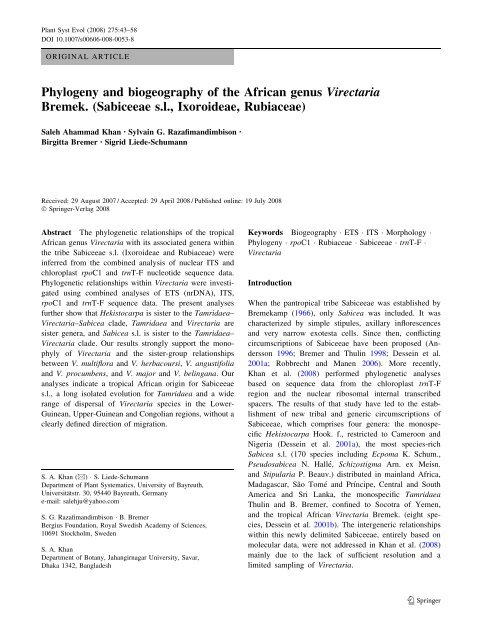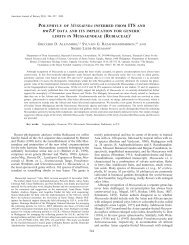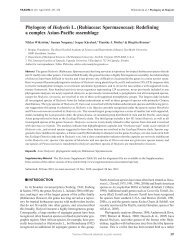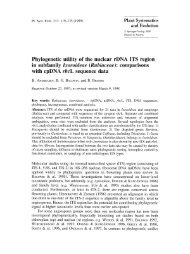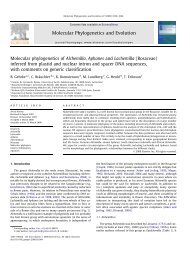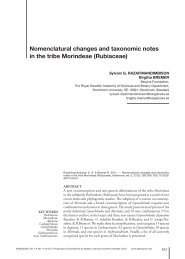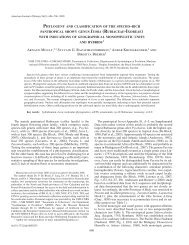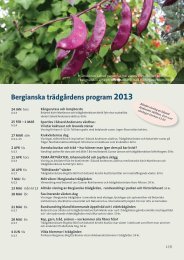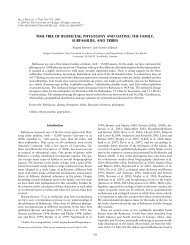Khan et al. (2008) - ResearchGate
Khan et al. (2008) - ResearchGate
Khan et al. (2008) - ResearchGate
You also want an ePaper? Increase the reach of your titles
YUMPU automatically turns print PDFs into web optimized ePapers that Google loves.
Plant Syst Evol (<strong>2008</strong>) 275:43–58DOI 10.1007/s00606-008-0053-8ORIGINAL ARTICLEPhylogeny and biogeography of the African genus VirectariaBremek. (Sabiceeae s.l., Ixoroideae, Rubiaceae)S<strong>al</strong>eh Ahammad <strong>Khan</strong> Æ Sylvain G. Razafimandimbison ÆBirgitta Bremer Æ Sigrid Liede-SchumannReceived: 29 August 2007 / Accepted: 29 April <strong>2008</strong> / Published online: 19 July <strong>2008</strong>Ó Springer-Verlag <strong>2008</strong>Abstract The phylogen<strong>et</strong>ic relationships of the tropic<strong>al</strong>African genus Virectaria with its associated genera withinthe tribe Sabiceeae s.l. (Ixoroideae and Rubiaceae) wereinferred from the combined an<strong>al</strong>ysis of nuclear ITS andchloroplast rpoC1 and trnT-F nucleotide sequence data.Phylogen<strong>et</strong>ic relationships within Virectaria were investigatedusing combined an<strong>al</strong>yses of ETS (nrDNA), ITS,rpoC1 and trnT-F sequence data. The present an<strong>al</strong>ysesfurther show that Hekistocarpa is sister to the Tamridaea–Virectaria–Sabicea clade, Tamridaea and Virectaria aresister genera, and Sabicea s.l. is sister to the Tamridaea–Virectaria clade. Our results strongly support the monophylyof Virectaria and the sister-group relationshipsb<strong>et</strong>ween V. multiflora and V. herbacoursi, V. angustifoliaand V. procumbens, and V. major and V. belingana. Ouran<strong>al</strong>yses indicate a tropic<strong>al</strong> African origin for Sabiceeaes.l., a long isolated evolution for Tamridaea and a widerange of dispers<strong>al</strong> of Virectaria species in the Lower-Guinean, Upper-Guinean and Congolian regions, without aclearly defined direction of migration.S. A. <strong>Khan</strong> (&) S. Liede-SchumannDepartment of Plant Systematics, University of Bayreuth,Universitätstr. 30, 95440 Bayreuth, Germanye-mail: s<strong>al</strong>ehju@yahoo.comS. G. Razafimandimbison B. BremerBergius Foundation, Roy<strong>al</strong> Swedish Academy of Sciences,10691 Stockholm, SwedenS. A. <strong>Khan</strong>Department of Botany, Jahangirnagar University, Savar,Dhaka 1342, BangladeshKeywords Biogeography ETS ITS Morphology Phylogeny rpoC1 Rubiaceae Sabiceeae trnT-F VirectariaIntroductionWhen the pantropic<strong>al</strong> tribe Sabiceeae was established byBremekamp (1966), only Sabicea was included. It wascharacterized by simple stipules, axillary inflorescencesand very narrow exotesta cells. Since then, conflictingcircumscriptions of Sabiceeae have been proposed (Andersson1996; Bremer and Thulin 1998; Dessein <strong>et</strong> <strong>al</strong>.2001a; Robbrecht and Manen 2006). More recently,<strong>Khan</strong> <strong>et</strong> <strong>al</strong>. (<strong>2008</strong>) performed phylogen<strong>et</strong>ic an<strong>al</strong>ysesbased on sequence data from the chloroplast trnT-Fregion and the nuclear ribosom<strong>al</strong> intern<strong>al</strong> transcribedspacers. The results of that study have led to the establishmentof new trib<strong>al</strong> and generic circumscriptions ofSabiceeae, which comprises four genera: the monospecificHekistocarpa Hook. f., restricted to Cameroon andNigeria (Dessein <strong>et</strong> <strong>al</strong>. 2001a), the most species-richSabicea s.l. (170 species including Ecpoma K. Schum.,Pseudosabicea N. H<strong>al</strong>lé, Schizostigma Arn. ex Meisn.and Stipularia P. Beauv.) distributed in mainland Africa,Madagascar, São Tomé and Príncipe, Centr<strong>al</strong> and SouthAmerica and Sri Lanka, the monospecific TamridaeaThulin and B. Bremer, confined to Socotra of Yemen,and the tropic<strong>al</strong> African Virectaria Bremek. (eight species,Dessein <strong>et</strong> <strong>al</strong>. 2001b). The intergeneric relationshipswithin this newly delimited Sabiceeae, entirely based onmolecular data, were not addressed in <strong>Khan</strong> <strong>et</strong> <strong>al</strong>. (<strong>2008</strong>)mainly due to the lack of sufficient resolution and <strong>al</strong>imited sampling of Virectaria.123
44 S. A. <strong>Khan</strong> <strong>et</strong> <strong>al</strong>.The Guineo–Congolian wide (Robbrecht 1996) genusVirectaria Bremek., the second largest genus of the tribe, ischaracterized by its herbaceous or subshrubby habit, lackof raphides, truncate stigmata, intern<strong>al</strong> indumentum(Verdcourt 1958) with flattened hairs, elongated flor<strong>al</strong> discand fruits with one persistent and one deciduous v<strong>al</strong>veduring dehiscence. All proposed species circumscriptionsof Virectaria are summarized in Table 1 [see Dessein <strong>et</strong> <strong>al</strong>.(2001b) for more information on the taxonomic history ofthe genus]. For this study, we adopted the circumscriptionof Dessein <strong>et</strong> <strong>al</strong>. (2001b), who presented a morphologybasedan<strong>al</strong>ysis of Virectaria, in which the seven of theeight Virectaria species were resolved in two major clades.This is the first phylogen<strong>et</strong>ic study of the genus Virectariabased on combined morphologic<strong>al</strong> and molecular(ETS, ITS, rpoC1 and trnT-F) data. This study wasundertaken with four go<strong>al</strong>s: (1) to assess rigorously thephylogen<strong>et</strong>ic relationships b<strong>et</strong>ween Virectaria and theother genera of Sabiceeae sensu <strong>Khan</strong> <strong>et</strong> <strong>al</strong>. (<strong>2008</strong>), (2) totest the monophyly of the genus Virectaria, (3) to test theinterspecific relationships within Virectaria postulated byDessein <strong>et</strong> <strong>al</strong>. (2001b) and (4) to infer the biogeography ofVirectaria.Materi<strong>al</strong>s and m<strong>et</strong>hodsPlant samplingTwenty-one species representing Virectaria and its <strong>al</strong>liedgenera were included in this study for the combined an<strong>al</strong>ysesof ITS, rpoC1 and trnT-F sequence data includingmorphologic<strong>al</strong> data to examine the relationships withinSabiceeae and to test the monophyly of Virectaria. Tenaddition<strong>al</strong> sequences of six Virectaria species were includedfor the separate an<strong>al</strong>ysis of each of the ITS, rpoC1 andtrnT-F data s<strong>et</strong>s, as well as their combined an<strong>al</strong>ysis tocompare the results. Two species of subfamily Ixoroideaes.l., Mussaenda pinatubensis Elmer (tribe Mussaendeae)and Warszewiczia coccinea Klotzsch (tribe Condamineeae)were used as outgroup taxa because they were shown tobelong to the sister clade of Sabiceeae s.l. by <strong>Khan</strong> <strong>et</strong> <strong>al</strong>.(<strong>2008</strong>). Eleven species including 16 individu<strong>al</strong>s of Virectariarepresenting six species were included in thecombined an<strong>al</strong>yses of molecular and morphologic<strong>al</strong> data toassess the phylogen<strong>et</strong>ic relationships within the genus. Fivespecies, Hekistocarpa minutiflora Hook. f., Tamridaeacapsulifera (B<strong>al</strong>f. f.) Thulin and B. Bremer, Sabicea becqu<strong>et</strong>ii(N. H<strong>al</strong>lé) Razafim., B. Bremer, Liede and <strong>Khan</strong>,Sabicea elliptica (Schweinf. ex Hiern) Hepper, and Sabiceaxanthotricha Wernham were used as outgroup taxa.Materi<strong>al</strong>s for Virectaria s<strong>al</strong>icoides (C. H. Wright) Bremek.,known only from the type and Virectaria tenella J. B. H<strong>al</strong>lwere not available.DNA isolation, amplification and sequencingDNA isolation, amplification and sequencing of the ITSregion were accomplished following the protocols describedin Alejandro <strong>et</strong> <strong>al</strong>. (2005) and Hassan <strong>et</strong> <strong>al</strong>. (2005)except the concentration of dH 2 O (15.8 lL) and DNAsamples (1.0 lL) following <strong>Khan</strong> <strong>et</strong> <strong>al</strong>. (<strong>2008</strong>). Theamplification and sequencing of the trnT-F region wereperformed following the protocols outlined in Razafimandimbisonand Bremer (2002). The amplification andsequencing of the ETS region were accomplished accordingto the protocols described in Razafimandimbison <strong>et</strong> <strong>al</strong>.(2005). The rpoC1 exon 1 including rpoC1 intron (parti<strong>al</strong>)was amplified using the two DNA barcoding primersrpoC1.2f (5 0 GGC AAA GAG GGA AGA TTT CG 3 0 ) andrpoC1.4r (5 0 CCA TAA GCA TAT CTT GAG TTG G 3 0 ).For each 25 lL PCR reaction we added 16.3 lL dH 2 O,1 lL MgCl 2 (25 mM), 2 lL dNTP (2 mM), 1 lL each offorward (rpoC1.2f) and reverse (rpoC1.4r) primer, (10pmol/lL), 2.5 lL PCR buffer (10X), 0.2 lL Taq(QIAGEN) DNA polymerase and 1 lL DNA sample.Table 1 Speciescircumscriptions of Virectariaa Lumped in Virectariaangustifoliab Merged in Virectaria majorSpecies Bremekamp (1952) Verdcourt (1953) H<strong>al</strong>lé (1966) Dessein <strong>et</strong> <strong>al</strong>. (2001b)V. angustifolia V. angustifolia V. angustifolia V. angustifolia V. angustifoliaV. belingana V. belingana V. belinganaV. herbacoursi V. herbacoursi V. herbacoursiV. h<strong>et</strong>eromera V. h<strong>et</strong>eromera – aV. kaessneri V. kaessneri – bV. major V. major V. major V. majorV. multiflora V. multiflora V. multiflora V. multiflora V. multifloraV. procumbens V. procumbens V. procumbens V. procumbens V. procumbensV. s<strong>al</strong>icoides V. s<strong>al</strong>icoides V. s<strong>al</strong>icoides V. s<strong>al</strong>icoidesV. tenella V. tenella123
Phylogeny and biogeography of Virectaria Bremek. 45PCR reaction was done with initi<strong>al</strong> denaturation for 3 min.at 94°C, followed by 30 cycles for 1 min. at 93°C, 1 min. at55°C, and finishing with 72°C for 2 min. Using the sameprimers, the sequencing reactions were conducted withABI PRISM big dye terminator cycle sequencingkit (Applied Biosystems, Bayreuth, Germany). ABIPrism Model 310, version 3.0, sequencer was used forsequencing.Morphologic<strong>al</strong> dataMorphologic<strong>al</strong> characters were recorded from 180 herbariumspecimens of different herbaria that belong to thespecies listed in Table 2. The reproductive parts werestudied after boiling in hot water for b<strong>et</strong>ter pliability.Twenty-six characters (Table 3) were coded for the morphologic<strong>al</strong>matrix (Table 4) that was included in thecombined ETS–ITS–rpoC1–trnT-F-morphologi<strong>al</strong> an<strong>al</strong>ysesfor examining the relationships within the genus. Theautapomorphic characters or fully or parti<strong>al</strong>ly overlappingcharacters were excluded from the an<strong>al</strong>ysis. A somewhatdifferent morphologic<strong>al</strong> matrix (available from the correspondingauthor) comprising 28 coded characters, mostlyof Table 3, was <strong>al</strong>so used in the combined ITS–rpoC1–trnT-F-morphologi<strong>al</strong> an<strong>al</strong>yses to test the monophyly of thegenus and its relationship with its <strong>al</strong>lied genera. Beforeselecting the fin<strong>al</strong> characters for the study, a morphologic<strong>al</strong>matrix of 51 coded characters (not shown) including someseed and p<strong>al</strong>ynologic<strong>al</strong> characters used by Dessein <strong>et</strong> <strong>al</strong>.(2001b) was included in the preliminary an<strong>al</strong>yses to assessthe influence of these characters on the resolution of thephylogen<strong>et</strong>ic an<strong>al</strong>yses. The characters of seed exotesta ofthe species of Sabicea were studied by SEM (PhilipsXL-30) following the procedure outlined in Alejandro <strong>et</strong> <strong>al</strong>.(2005) and those of other genera (excluding M. pinatubensisand W. coccinea) were based on Dessein <strong>et</strong> <strong>al</strong>.(2001a, 2001b).Data an<strong>al</strong>ysesThe forward and reverse sequences of the ETS, ITS,rpoC1 and trnT-F were assembled in Perkin Elmersequence Navigator, version 1.0.1 and Sequencher 3.1.1.The consensus sequences were <strong>al</strong>igned and modifiedmanu<strong>al</strong>ly. Potenti<strong>al</strong>ly informative indels were codedusing the simple gap coding m<strong>et</strong>hod (Simmons andOchoterena 2000). Maximum parsimony an<strong>al</strong>yses (MPA)of the combined ITS–rpoC1–trnT-F and ETS–ITS–rpoC1–trnT-F matrices, including and excluding themorphologic<strong>al</strong> matrix, were performed in PAUP, version4.0b (Swofford 2000). All data matrices were an<strong>al</strong>yzedusing the following heuristic search s<strong>et</strong>tings: MUL-TREES option on, tree-bisection-reconnection (TBR)branch swapping, swap on best only in effect, and 5,000random addition sequences. Consistency index (CI, Klugeand Farris 1969) and r<strong>et</strong>ention index (RI, Farris 1989)were c<strong>al</strong>culated to estimate homoplasy. Bootstrap an<strong>al</strong>yseswere performed using 10,000 replicates, MULTREESoption on, TBR branch swapping and five random additionsequences to assess the support of the resolvedclades. In <strong>al</strong>l an<strong>al</strong>yses, we fin<strong>al</strong>ly used the baselinematrices avoiding the coding of indels; however, tocompare the results, we performed addition<strong>al</strong> parsimonyan<strong>al</strong>yses including the coded indels, but excluding thecoded positions and the results are mentioned only whenthese differed from those based on baseline matrices. Infin<strong>al</strong> an<strong>al</strong>yses, <strong>al</strong>l characters were given equ<strong>al</strong> weight,gaps were treated as missing data, and only parsimonyinformativecharacters were included. To explore thecombinability of <strong>al</strong>l data s<strong>et</strong>s included in the ITS–rpoC1–trnT-F and ETS–ITS–rpoC1–trnT-F matrices, we conductedthe ILD test as implemented in PAUP*, andcompared the tree topologies generated from separatean<strong>al</strong>yses of each data s<strong>et</strong>.To ev<strong>al</strong>uate the statistic<strong>al</strong>ly potenti<strong>al</strong> monophyl<strong>et</strong>icgroups, Bayesian an<strong>al</strong>yses (BA) were performed inMrBayes, version 3.1.2 (Huelsenbeck and Ronquist 2001;Ronquist and Huelsenbeck 2003) using the substitutionmodel param<strong>et</strong>ers: Prs<strong>et</strong> statefreqpr = dirichl<strong>et</strong> (1,1,1,1),Ls<strong>et</strong> nst = 6 rates = equ<strong>al</strong>, selected for the best fit model(GTR + I+G) by both hierarchic<strong>al</strong> likelihood ratio tests(hLRT) and Akaike information criterion (AIC) inMrModeltest, version 2.2 (Nylander 2004) for the uncodedand combined ITS–rpoC1–trnT-F and ETS–ITS–rpoC1–trnT-F data s<strong>et</strong>s. In the combined an<strong>al</strong>yses includingmorphologic<strong>al</strong> matrix, the morphologic<strong>al</strong> character partitionwas treated as standard and the model param<strong>et</strong>ers ls<strong>et</strong>applyto = (1/DNA) nst = 6 rates = invgamma; unlink shape= (<strong>al</strong>l) pinvar = (<strong>al</strong>l) statefreq = (<strong>al</strong>l) revmat = (<strong>al</strong>l); prs<strong>et</strong>ratepr = variable; were applied. In <strong>al</strong>l searches, the defaults<strong>et</strong>tings (MrBayes, version 3.1.2) were used for <strong>al</strong>l activeparam<strong>et</strong>ers for the corresponding substitution models aswell as for the heating scheme. Eight chains under twosimultaneous runs with 100 sample frequencies were executedand monitored up to 3.5–4.5 9 10 6 Markov ChainMonte Carlo (mcmc) generations for arriving at the stationaryphase. Exactly 25% of the samples were discardedas burn-in. The graphic<strong>al</strong> presentations of summarizedresulting trees were generated in PAUP* and Tree View(Page 1996). Internodes with posterior probabilities ofmore than 95% were considered as strongly supported.To assess the evolution of morphologic<strong>al</strong> characters,selected characters were plotted on the strict consensustree, generated from the parsimony an<strong>al</strong>ysis of ETS–ITS–rpoC1–trnT-F matrix, through importing it into MacClade,version 4.0 (Madison and Madison 2000).123
46 S. A. <strong>Khan</strong> <strong>et</strong> <strong>al</strong>.Table 2 List of specimens used in this study, voucher information and GenBank accession numbersTaxa Country origins Voucher information/referenceETS ITS rpoC1 trnT-FHekistocarpa minutifloraHook. f. (1)Hekistocarpa minutifloraHook. f. (2)Cameroon Sonké <strong>et</strong> <strong>al</strong>. 2708 (BR) FM160674 AM981273 AM982749 AM982730Cameroon Etuge and Thomas 143(WAG)AM981274 AM982750 AM982731Mussaenda pinatubensis Elmer Philippines Alejandro 098 (UBT) AJ846851 AM982780 AJ847365Sabicea aspera Aubl. French Guiana Andersson <strong>et</strong> <strong>al</strong>. (2003)AM409008 AM982751 AM409143(NY)Sabicea becqu<strong>et</strong>ii (N. H<strong>al</strong>lé)Razafim., B. Bremer, Liedeand <strong>Khan</strong>Burundi Reekmans 11116 (WAG) AM409049 AM982752 AM409167Sabicea caminata N. H<strong>al</strong>lé Gabon Wilde and Sosef 10311(WAG)Sabicea ceylanica Puff Sri Lanka Jongkind <strong>et</strong> <strong>al</strong>. 1516(UPS)Sabicea elliptica (Schweinf.ex Hiern) HepperDemocraticRepublic ofCongoAM409010 AM982753 AM409118AM981275 AM982754 AM982732Lisowski 56663 (BR) AM409058 AM982755 AM409169Sabicea hierniana Wernham Gabon Wilde 11714 (WAG) AM981276 AM982756 AM982733Sabicea medusula K. Schum.ex Wernh.Cameroon Andel <strong>et</strong> <strong>al</strong>. 3555(WAG)AM409047 AM982757 AM409163Sabicea mildbraedii Wernham Gabon Wieringa 5032 (WAG) AM409051 AM982758 AM409137Sabicea mexicana Wernham Mexico Mendoza <strong>et</strong> <strong>al</strong>. 1329AM981277 AM982760 AM982734(NY)Sabicea nobilis Good Gabon V<strong>al</strong>kenburg 2604AM409052 AM982759 AM409165(WAG)Sabicea xanthotricha Wernham Cameroon Sonké 1082 (BR) AM409045 AM982762 AM409151Sabicea venosa Benth.Centr<strong>al</strong> African Sonké and Benia 2797AM409041 AM982761 AM409134Republic(WAG)Tamridaea capsulifera (B<strong>al</strong>f. f.) Yemen Miller <strong>et</strong> <strong>al</strong>. 10087 (UPS) AM409059 AM982763 AM409170Thulin and B. BremerVirectaria angustifolia (Hiern) Gabon Wieringa 4730 (WAG) FM160675 AM981278 AM982764 AM982735Bremek.Virectaria belingana N. H<strong>al</strong>lé (1) Gabon Parmentier 2336 (BRLU) FM160676 AM981279 AM982765 AM982736Virectaria belingana N. H<strong>al</strong>lé (2) Equatori<strong>al</strong> Guinea Parmentier 3675 (BRLU) FM160666 AM981280 AM982766 AM982737Virectaria belingana N. H<strong>al</strong>lé (3) Equatori<strong>al</strong> Guinea Obama and Lejoly 620(BRLU)FM160667 AM981281 AM982767 AM982738Virectaria herbacoursi N. H<strong>al</strong>lévar. p<strong>et</strong>rophila (1)Virectaria herbacoursi N. H<strong>al</strong>lévar. p<strong>et</strong>rophila (2)Virectaria major (K. Schum.)Verdc. subsp. spathulata(Verdc.) Dessein & Robbr. (1)Virectaria major (K. Schum.)Verdc. subsp. major (2)Virectaria multiflora (Sm.)Bremek. (1)Virectaria multiflora (Sm.)Bremek. (2)Virectaria multiflora (Sm.)Bremek. (3)Virectaria multiflora (Sm.)Bremek. (4)Equatori<strong>al</strong> GuineaParmentier and Esono3375 (BRLU)Equatori<strong>al</strong> Guinea Lejoly and Elad 98/73(BRLU)DemocraticRepublic ofCongoFM160668 AM981284 AM982768 AM982739FM160669 AM981285 AM982769 AM982740Lejoly 2934 (BR) FM160670 AM981282 AM982770 AM982741Tanzania Kayombo 1842 (BR) FM160671 AM981283 AM982771 AM982742Ivory Coast Leeuwenberg 2295(UPS)FM160672 AM409060 AM982772 AM409171Liberia Adams 606 (UPS) FM160673 AM981286 AM982773 AM982743CongoChampluvier S109(BR)AM981184 AM981287 AM982774 AM982744Gabon Sosef <strong>et</strong> <strong>al</strong>. 551(WAG) AM981185 AM981288 AM982775 AM982745123
Phylogeny and biogeography of Virectaria Bremek. 47Table 2 continuedTaxa Country origins Voucher information/referenceETS ITS rpoC1 trnT-FVirectaria procumbens(Sm.) Bremek. (1)Virectaria procumbens(Sm.) Bremek. (2)Gabon Tabak <strong>et</strong> <strong>al</strong>. 182/189(WAG)Equatori<strong>al</strong> Guinea Obama and Lejoly 538(BRLU)AM981186 AM981289 AM982776 AM982746AM981187 AM981290 AM982777 AM982747Virectaria sp. 1 Liberia Adams 453 (UPS) AM981188 AM409061 AM982778 AM409172Virectaria sp. 2 Cameroon Nemba and Thomas AM981189 AM982729 AM982779 AM982748321 (WAG)Warszewiczia coccinea Klotzsch South America Delpr<strong>et</strong>e 6437 (UPS) AJ846884 AM982781 AJ847397Table 3 Morphologic<strong>al</strong> characters and character states used in the phylogen<strong>et</strong>ic an<strong>al</strong>ysesChar.No.Characters and character states1. Plant habit: 0-herb, often woody at the base, 1-liana or vine, 2-(sub-) shrub and 3-tree2. Stem: 0-erect, 1-climbing and 2-straggling3. Stipule’s shape: 0-oblong to lingulate, 1-ovate to deltate, 2-triangular and 3-lanceolate4. Stipule orientation: 0-antrorse and appressed, 1-antrorse and spread, 2-moderately decurved and 3-recurved to slightly reflexed5. Lobes of stipules: 0-at least 2 lobes present and 1-lobes absent6. Length-width ratios of leaf blade: 0—\3, 1—3–6, 2—[67. Shape of leaf blades: 0-elliptic to oblong, 1-lanceolate, 2-ovate to widely lanceolate and 3-very narrowly elliptic to obovate oroblanceolate8. Indument of upper surface of leaf blades: 0-covered with indument at least <strong>al</strong>ong the veins, 1-glabrescent and 2-glabrous9. Number of flower per inflorescence: 0-one, som<strong>et</strong>imes three, 1-few and 2-many10. C<strong>al</strong>yx: 0-campanulate, 1-tubes nearly indistinct and 2-infundibuliform11. Length–width ratios of c<strong>al</strong>yx lobes: 0—\2, 1—2–5, 2—[512. Apex of c<strong>al</strong>yx lobes: 0-acuminate to apiculate, 1-obtuse and 2-(sub-)acute13. Hairiness of c<strong>al</strong>yx lobes margins: 0-eciliate and 1-ciliate or ciliolate14. Indument of outer surface of c<strong>al</strong>yx lobes: 0-covered with indument, 1-glabrescent and 2-glabrous15. Trichomes of c<strong>al</strong>yx lobes: 0-appressed and ±straight, 1-erecto-patent and ±straight and 2-(sub-) appressed to erecto-patent and ±straight or curled16. Long, stiff trichomes on outside of c<strong>al</strong>yx lobes: 0-absent and 1-present17. Length-width ratios of corolla lobes: 0—\1 and 1—[118. Hairiness of corolla lobe margins: 0-eciliate and 1-ciliate or ciliolate19. Indument cover of outer surface of corolla: 0-covered with indument, 1-glabrous and 2-glabrescent20. Trichomes of outer surface of corolla: 0-appressed and ± straight, 1-erecto-patent and ± straight, 2–appressed to erecto-patent and ±straight and 3-(sub-) appressed to erecto-patent and curled21. Protrusion of anthers: 0-included in corolla tubes and apic<strong>al</strong>ly with or without protrusion beyond the tubes and 1-compl<strong>et</strong>elyprotrusion beyond corolla tubes22. Protrusion of style: 0-exserted part is longer than the corolla lobes, 1-exserted part is not longer than the corolla lobes and 2-includedin corolla tube with or without projecting tip of stigmatic lobes23. Flower disc: 0-divided into two bilobed parts, 1-undivided and cylindric<strong>al</strong> and 2-undivided and sh<strong>al</strong>lowly campanulate24. Fruit dehiscence: 0-fruits dehiscent but margins do not fold inwards, 1-fruits dehiscent and margins fold inwards and 2-fruitsindehiscent25. Elongation of exotesta cells: 0-elongated and 1-strongly elongated26. Trichomes of flowering branchl<strong>et</strong>s and lower surface of leaves: 0-long and 1-short123
48 S. A. <strong>Khan</strong> <strong>et</strong> <strong>al</strong>.Table 4 Morphologic<strong>al</strong> matrix for Virectaria and outgroup taxaTaxa Character states for characters 1–261 2 3 4 5 6 7 8 9 10 11 12 13 14 15 16 17 18 19 20 21 22 23 24 25 26Hekistocarpa minutiflora 0 1&2 3 1&3 1 1 3 0 2 0 0 2 0 1 2 0 0 0 1 - 0 2 2 0&2 0 1Sabicea becqu<strong>et</strong>ii 1 1 1 1&3 0&1 0 0&1 0&1 1 0 1 0 1 0 2 0 0 0&1 0 3 0 2 2 2 1 0S. xanthotricha 1 1 1 0&1 1 0 0 0 1&2 0 2 0 1 0 2 0 0 0 1 - 0 2 2 2 1 1S. elliptica 2 0 1 0 1 0 0 2 1 0 0&1 2 1 0 0 0 0 0 1 - 0 1 2 2 1 0Tamridaea capsulifera 2&3 0 2 0 1 0 0 2 1 0 1 1 0 1 0 0 0 0 0 0 0 2 2 0 1 1Virectaria angustifolia 0&2 0 3 0&1 1 1&2 3 2 1 1 1 1&2 1 2 - 0 0 0 1 - 1 1 1 1 1 1V. belingana 1 0&2 0 3 0&1 1 0 2 0&1 1&2 1 1 0&2 1 1 2 0 1 0 0 0 1 0 1 0&1 1 1V. belingana 2 0&2 0 3 0&1 1 0 2 0&1 1&2 1 1 0&2 1 1 2 0 1 0 0 0 1 0 1 0&1 1 1V. belingana 3 0&2 0 3 0&1 1 0 2 0&1 1&2 1 1 0&2 1 1 2 0 1 0 0 0 1 0 1 0&1 1 1V. herbacoursi 1 0 0 0 2 0 1 3 0&1 2 1 1 2 0 0 1 1 1 0&1 0 1 1 0 0 0 0 0V. herbacoursi 2 0 0 0 2 0 1 3 0&1 2 1 1 2 0 0 1 1 1 0&1 0 1 1 0 0 0 0 0V. major 1 1 0&2 3 1 0&1 0&1 0&2 0 2 1 1&2 0&2 1 0 2 0&1 1 1 0 2 1 0 1 0 1 0V. major 2 2 0&2 3 1 0&1 0&1 0&2 0 2 1 1&2 0&2 1 0 1 0&1 1 1 0 1 1 0 1 0 1 0V. multiflora 1 0 0 3 1 0 0 2&3 0 2 1 2 2 1 0 1 1 1 1 0 2 1 0 0 0 0 0V. multiflora 2 0 0 3 1 0 0&1 2&3 0 2 1 2 2 1 0 1 1 1 1 0 2 1 0 0 0 0 0V. multiflora 3 0 0 3 1 0 1 2&3 0 2 1 2 2 1 0 1 1 1 1 0 2 1 0 0 0 0 0V. multiflora 4 0 0 3 1 0 1 2&3 0 2 1 2 2 1 0 1 1 1 1 0 2 1 0 0 0 0 0V. procumbens 1 0 0&2 3 3 1 0 0&2 0 1 1 0&1 1 1 0 0 0 0&1 1 0 2 1 1 1 1 1 1V. procumbens 2 0 0&2 3 3 1 0 0&2 0 1 1 0&1 1 1 0 0 0 0&1 1 0 2 1 1 1 1 1 1Virectaria sp. 1 0 0&2 3 3 1 0 0&2 0 1 1 0&1 1 1 0 0 0 0&1 1 0 2 1 1 1 1 1 1Virectaria sp. 2 0&2 0 3 0&1 1 2 3 0 1 1 1 1&2 1 2 - 0 0 1 1 0 1 1 1 1 1 1123
Phylogeny and biogeography of Virectaria Bremek. 49Table 5 Descriptions of combined maximum parsimony an<strong>al</strong>yses and resulting treesData partitions and an<strong>al</strong>yses Outgroup/ingroup taxa No. informative characters Length CI RI No. MP treesITS + rpoC1 + trnT-F 2/21 293 546 0.685 0.853 2ITS + rpoC1 + trnT-F + morphology 2/21 321 673 0.633 0.814 1ETS + ITS + rpoC1 5/16 200 324 0.750 0.888 1ETS + ITS + rpoC1 + morphology 5/16 226 421 0.708 0.863 4ITS + rpoC1 + trnT-F 5/16 239 376 0.758 0.883 6ITS + rpoC1 + trnT-F + morphology 5/16 265 475 0.726 0.864 6ETS + ITS + rpoC1 + trnT-F 5/16 293 462 0.751 0.886 2ETS + ITS + rpoC1 + trnT-F + morphology 5/16 319 542 0.720 0.867 1ResultsPhylogen<strong>et</strong>ic an<strong>al</strong>ysesDescription of <strong>al</strong>l MPA of the combined data s<strong>et</strong>s andresulting trees are summarized in Table 5.Separate an<strong>al</strong>ysis of ITS, rpoC1 and trnT-F data. Theresults of the ILD test supported the combinability of theITS, rpoC1 and trnT-F data s<strong>et</strong>s of the 23 taxa used inev<strong>al</strong>uating the relationships b<strong>et</strong>ween the genera of Sabiceeaeand testing the monophyly of Virectaria (Table 6).However, the tree topologies of the strict consensus treesresulted from the separate an<strong>al</strong>yses of ITS, rpoC1 and trnT-F data (results not shown) appeared conflicting regardingthe positions of Hekistocarpa and Tamridaea. But neitherof the positions was supported by more than 50% BS. Inboth ITS and trnT-F an<strong>al</strong>yses (results not shown), Hekistocarpawas resolved as sister (BS 100) to the clade ofTamridaea: Sabicea and Virectaria (BS 57, ITS, BS 54,trnT-F). In rpoC1 an<strong>al</strong>ysis, Tamridaea, instead of Hekistocarpa(ITS or trnT-F tree), was resolved as sister (BS 98)to an unsupported Hekistocarpa–Virectaria Sabicea clade(BS \50). In an an<strong>al</strong>ysis of our trnT-F data (results notshown) Tamridaea and Sabicea s.l. were resolved as aweakly supported monophyl<strong>et</strong>ic group (BS 60) in theunsupported Tamridaea–Sabicea–Virectaria clade (BS\50).Table 6 Scores of incongruency length difference (ILD) test for thecombinability of ITS and trnT-F data partitions (*P \ 0.05) withoutexcluding any taxaData partitions P v<strong>al</strong>ues SignificanceITS, rpoC1and trnT-F of 23 taxa 0.916000 CongruentETS, ITS and rpoC1 of 21 taxa 0.132000 CongruentITS, rpoC1 and trnT-F of 21 taxa 0.088000 CongruentETS, ITS, rpoC1 and trnT-F of 21 taxa 0.004000 IncongruentETS, ITS, rpoC1 and trnT-F of 17 taxa(excluding T. capsulifera, S. becqu<strong>et</strong>ii,S. elliptica and S. xanthotricha)0.002000 IncongruentBased on the results of the ILD test and lack of support forthe topologic<strong>al</strong> conflicts, we combined the ITS, rpoC1 andtrnT-F data s<strong>et</strong>s.Combined ITS–rpoC1–trnT-F an<strong>al</strong>yses. The strict consensusof two most parsimonious trees generated from thecombined an<strong>al</strong>yses of the ITS, rpoC1 and trnT-F data of 23taxa (Fig. 1) exhibited strong support to the clade of Sabiceeaesensu <strong>Khan</strong> <strong>et</strong> <strong>al</strong>. in which two Hekistocarpaaccessions were shown to be sister to a weakly to moderatelysupported clade comprising Tamridaea, six species ofVirectaria and twelve species of Sabicea s.l. This Tamridaea–Virectaria–Sabiceaclade was further resolved intotwo major clades, the moderately to strongly supportedTamridaea–Virectaria clade, which was resolved withweak to moderate support as sister to the Sabicea clade.Within the Tamridaea–Virectaria clade, Tamridaea wasconsistently shown to be sister to the strongly supportedmonophyl<strong>et</strong>ic group comprising <strong>al</strong>l Virectaria species(hereafter Virectaria clade). Within the Virectaria clade,V. herbacoursi N. H<strong>al</strong>lé and V. multiflora (Sm.) Bremek.formed a strongly supported clade (hereafter V. herbacoursi–V.multiflora clade), which was further resolved assister to the strongly supported clade formed by V. angustifolia(Hiern) Bremek. V. procumbens (Sm.) Bremek.V. belingana N. H<strong>al</strong>lé and V. major (K. Schum.) Verdc.(hereafter V. angustifolia–V. procumbens–V. belingana–V. major clade). This clade of four Virectaria accessionswas resolved into two subclades, the strongly supportedV. angustifolia–V. procumbens subclade and the moderatelysupported V. belingana–V. major subclade. TheTamridaea–Virectaria clade or a Tamridaea resolved assister to Virectaria was weakly supported when 28 morphologic<strong>al</strong>characters (not shown) were included in thean<strong>al</strong>yses. The topology of the most parsimonious treegenerated from the combined ITS–rpoC1–trnT-F tree wassimilar to that resulting from the separate an<strong>al</strong>ysis of theITS data s<strong>et</strong>, except for S. hierniana Wernham, S. caminataN. H<strong>al</strong>lé, S. ceylanica Puff and S. nobilis Good or the trnT-F data s<strong>et</strong>, except for T. capsulifera, and few accessions of123
50 S. A. <strong>Khan</strong> <strong>et</strong> <strong>al</strong>.Fig. 1 Strict consensus treebased on the combinedphylogen<strong>et</strong>ic an<strong>al</strong>ysis of theITS–rpoC1–trnT-F data. Thenumbers above the branches arebootstrap support v<strong>al</strong>ues([50%), those below thebranches are Bayesian posteriorprobabilities ([95%), thoseafter slash are the support frommorphologic<strong>al</strong> data, and thosein brack<strong>et</strong>s are the supports du<strong>et</strong>o the indels. The taxa shown inboldface are the sequencedindividu<strong>al</strong>s of monospecificHekistocarpa and TamridaeaSabicea (e.g. S. hierniana, S. nobilis and S. mexicanaWernham) and Virectaria (e.g. V. angustifolia, V. major,and V. procumbens). The strict consensus tree generatedfrom a separate an<strong>al</strong>ysis of rpoC1 data (not shown) wasunresolved except for the clades of Sabiceeae s.l. and Sabiceas.l.Separate an<strong>al</strong>ysis of the ETS, ITS, rpoC1 and trnT-Fdata. The results of the ILD test did not support the combinabilityof ETS, ITS, rpoC1 and trnT-F data s<strong>et</strong>s toassess the infraspecific relationships and biogeographywithin the genus. But the combinability of either the ETS,ITS and rpoC1 or the ITS, rpoC1 and trnT-F data s<strong>et</strong>s weresupported (Table 6). On the other hand, the separatean<strong>al</strong>yses of each of the ETS, ITS and trnT-F data s<strong>et</strong>s andthe ETS–ITS–rpoC1, ITS–rpoC1–trnT-F and ETS–ITS–rpoC1–trnT-F matrices (results not shown) imparted theunsupported topologic<strong>al</strong> conflicts in resolving the twoV. herbacoursi accessions as sister group to the subclade ofV. multiflora accessions (e.g. ITS, trnT-F, ITS–rpoC1–trnT-F, ETS–ITS–rpoC1–trnT-F trees) versus the clade of<strong>al</strong>l Virectaria accessions (e.g. ETS tree). Based on the lackof clear-cut evidence to the reason of incongruence of ETS,ITS, rpoC1 and trnT-F data s<strong>et</strong>s or the topologic<strong>al</strong> conflicts,we combined these four data s<strong>et</strong>s. Fin<strong>al</strong>ly, to describ<strong>et</strong>he infraspecific relationships within the genus, we presentour results based on the combined ETS–ITS–rpoC1–trnT-Fan<strong>al</strong>yses.Combined ETS–ITS–rpoC1–trnT-F an<strong>al</strong>yses. In themost parsimonious ETS–ITS–rpoC1–trnT-F tree (Fig. 2),the sampled Virectaria formed a strongly supportedmonophyl<strong>et</strong>ic group, in which <strong>al</strong>l individu<strong>al</strong>s were resolvedin two major clades: the moderately to strongly supportedVirectaria herbacoursi–Virectaria multiflora clade (hereafterClade A; Fig. 2), and the strongly supported123
Phylogeny and biogeography of Virectaria Bremek. 51Fig. 2 Strict consensus tree based on the combined phylogen<strong>et</strong>ican<strong>al</strong>ysis of the ETS–ITS–rpoC1–trnT-F data. The numbers above thebranches are bootstrap support v<strong>al</strong>ues ([50%), those below thebranches are Bayesian posterior probabilities ([95%), those afterslash are the support from morphologic<strong>al</strong> data, and those in brack<strong>et</strong>sare the supports due to the indels. Virectaria sp. 2 and V. angustifolia,delimited with brack<strong>et</strong>, form a subclade when morphologic<strong>al</strong> data areincluded in the an<strong>al</strong>yses. V. herbacoursi (=V. herbacoursi var.p<strong>et</strong>rophila); V. major 1(=V. major subsp. spathulata); V. major 2(=V. major subsp. major). Clade A = V. herbacoursi–V. multifloraclade; Clade B = Virectaria sp.–V. angustifolia–V. procumbens–V.major–V. belingana clade; I = V. multiflora subclade; II = Virectariasp.–V. angustifolia–V. procumbens subclade; III = the V. major–V.belingana subclade. CO = Congolian element, LG = Lower-Guineanelement, UG = Upper-Guinean element and ZA = Zambezian elementVirectaria sp.–Virectaria angustifolia–Virectaria procumbens–Virectariamajor–Virectaria belingana clade(hereafter Clade B; Fig. 2). Clade A is further resolved assister to Clade B. Within Clade A, two accessions ofV. herbacoursi were resolved as sister (hereafter subcladeAI; Fig. 2) to the strongly supported subclade comprising<strong>al</strong>l sampled V. multiflora accessions (hereafter subcladeAII; Fig. 2).Within Clade B, the two Virectaria sp., one V. angustifolia,and two V. procumbens accessions formed a stronglysupported subclade (hereafter subclade BIII; Fig. 2) whichwas further resolved as sister to another moderately supportedsubclade consisting of two subspecies of V. major(V. major 1=V. major (K. Schum.) Verdc. subsp. spathulata(Verdc.) Dessein & Robbr. V. major 2=V. major(K. Schum.) Verdc. subsp. major) and three accessions ofV. belingana (hereafter subclade BIV; Fig. 2). In subcladeBIII, Virectaria sp. 1 was resolved as sister to the moderatelysupported group of Virectaria sp. 2, V. angustifoliaand two V. procumbens accessions. Within this group,Virectaria sp. 2 was resolved with weak to moderatesupport as sister to the well-supported group of oneV. angustifolia and two V. procumbens accessions, whileV. angustifolia was further resolved with moderate tostrong support as sister to the moderately to strongly supportedmonophyl<strong>et</strong>ic group of two V. procumbensaccessions. Within subclade BIV, the two sampled subspeciesof V. major, forming a strongly supportedmonophyl<strong>et</strong>ic group, were resolved as sister to the stronglysupported monophyl<strong>et</strong>ic group of three V. belinganaaccessions (Fig. 2). The topology of the combined ETS–ITS–rpoC1 tree was similar to that of the strict consensustree generated from the separate ETS an<strong>al</strong>ysis, except forthe position of two V. herbacoursi accessions. The123
Phylogeny and biogeography of Virectaria Bremek. 53Fig. 3 Distribution patterns of some important characters on thestrict consensus tree generated from the combined an<strong>al</strong>ysis of ETS–ITS–rpoC1–trnT-F data s<strong>et</strong>s; a length of c<strong>al</strong>yx tubes and position ofanthers, b division of stipules and long stiff trichomes on c<strong>al</strong>yx lobes,c length–breadth ratios of corolla lobes, d margins of corolla lobes, eextern<strong>al</strong> surface of corolla lobes, f protruding of styles, g division andshape of flor<strong>al</strong> disc, h fruit dehiscence and folding of v<strong>al</strong>ves123
54 S. A. <strong>Khan</strong> <strong>et</strong> <strong>al</strong>.Fig. 3 continuedMonophyly of VirectariaThe morphologic<strong>al</strong> characteristics (Verdcourt 1953;Table 4; Dessein <strong>et</strong> <strong>al</strong>. 2001b) of the herbaceous to semiwoodygenus Virectaria support its position in Rubiaceaeand Sabiceeae, which is confirmed by molecular data(Bremer and Thulin 1998; <strong>Khan</strong> <strong>et</strong> <strong>al</strong>. <strong>2008</strong>). Although themonophyly of the genus has never been doubted, it has <strong>al</strong>sonever been assessed using molecular phylogen<strong>et</strong>ic an<strong>al</strong>ysis.In <strong>Khan</strong> <strong>et</strong> <strong>al</strong>. (<strong>2008</strong>), two Virectaria species (V. multifloraand V. procumbens) form a monophyl<strong>et</strong>ic group. In <strong>al</strong>lan<strong>al</strong>yses of the present study including morphologic<strong>al</strong> data123
Phylogeny and biogeography of Virectaria Bremek. 55Table 7 Characteristics of the non-<strong>al</strong>igned sequences and their description in <strong>al</strong>ignmentsMarkersLength ranges ofsequences (bp)Ranges of GCcontents insequences (%)Number of positionsin <strong>al</strong>ignmentsParsimony-informativecharacters in <strong>al</strong>ignmentsParsimony-uninformativevariable charactersin <strong>al</strong>ignmentsETS region 358–449 46.7–50.01 –/455 –/54 –/15ITS region 584–713 53.7–65.5 638/616 164/140 82/60ITS1 186–294 52.7–68.7 245/228 83/75 42/28S5.8 147–165 53.3–66.1 165/165 05/05 00/00ITS2 156–279 53.6–71.6 228/223 76/60 36/32rpoC1 region 493–519 41–43 484/484 12/06 04/03rpoC1 exon 1 399–416 41.3–43.3 399/400 12/06 04/03rpoC1 intron(parti<strong>al</strong>)94–103 44.7–46.8 85/85 00/00 04/00trnT-F region 1292–1669 28.2–36.7 1,810/1760 117/93 186/70trnT-L spacer 388–774 24.1–32.5 838/826 71/53 110/50trnL spacer 537–615 36.7–44.1 641/606 22/13 36/10trnL intron 455–530 35.3–42.8 556/521 22/13 32/08trnL-F spacer 313–327 32.1–36.1 331/328 24/27 40/10The v<strong>al</strong>ues before the slash mark correspond to the combined ITS–rpoC1–trnT-F matrix and those after the slash mark to the ETS–ITS–rpoC1–trnT-F matrix(Figs. 1, 2), <strong>al</strong>l sampled Virectaria are constantly resolvedas one strongly supported monophyl<strong>et</strong>ic group.Morphologic<strong>al</strong> characters like eciliate or ciliolate marginsof corolla lobes (Fig. 3d), glabrous or hairy extern<strong>al</strong>surfaces of corolla (Fig. 3e) and length of exserted part ofstyle (Fig. 3f) seem to have evolved independently in thesampled taxa of Sabiceeae s.l. and are thus not useful forphylogen<strong>et</strong>ic conclusions. However, there are sever<strong>al</strong>morphologic<strong>al</strong> characters supporting the genus Virectaria,such as compl<strong>et</strong>ely exserted anthers (Fig. 3a), truncatedstigmata, intern<strong>al</strong> indumenta with flattened hairs, presenceof elongated but non-campanulate flower disc (Fig. 3g) anddehiscent fruits (Fig. 3h) with capsules splitting into onepersistent and one deciduous v<strong>al</strong>ve. Therefore, the monophylyof the genus Virectaria is strongly supported by bothmolecular and morphologic<strong>al</strong> an<strong>al</strong>yses and easily identifiedby the sever<strong>al</strong> distinct morphologic<strong>al</strong> characters. On theother hand, the constant resolving of <strong>al</strong>l sampled species ofSabicea as a monophyl<strong>et</strong>ic group conforms to Sabicea s.l.(<strong>Khan</strong> <strong>et</strong> <strong>al</strong>. <strong>2008</strong>).Relationships within VirectariaThe previous studies discussing the relationships within thegenus Virectaria (Verdcourt 1953; Dessein <strong>et</strong> <strong>al</strong>. 2001b)were exclusively based on morphologic<strong>al</strong> data. The over<strong>al</strong>ltree topology of our most parsimonious ETS–ITS–rpoC1–trnT-F tree or ETS–ITS–rpoC1–trnT-F-morphology tree(Fig. 2) is mostly consistent to that of Dessein <strong>et</strong> <strong>al</strong>.(2001b). The groups of Virectaria species resolved in twomajor clades (Clade A and Clade B) are strongly supportedby both molecular and morphologic<strong>al</strong> data.Virectaria herbacoursi–Virectaria multiflora clade(Clade A). Within Clade A (Fig. 2), V. herbacoursi is wellresolved as sister (Fig. 2: AI) to V. multiflora (Fig. 2: AII),consistent with Dessein <strong>et</strong> <strong>al</strong>. (2001b). This clade is distinctfrom its sister Clade B by the following four morphologic<strong>al</strong>characters: 2–3 distinct lobes of stipules, long and stifftrichomes on outer c<strong>al</strong>yx lobe surfaces, and two lanceolateand bilobed parts of flor<strong>al</strong> disc (Figs. 3b, g), and broadexotesta cells and sm<strong>al</strong>ler pollen (Dessein <strong>et</strong> <strong>al</strong>. 2001b). Inother words, the close relationship of V. herbacoursi withV. multiflora is strongly supported by both molecular andmorphologic<strong>al</strong> data. V. herbacoursi can easily be distinguishedfrom V. multiflora by its 1–2 trichomesconsistently present on the outer c<strong>al</strong>yx lobe surface incontrast to <strong>al</strong>most more than two, usu<strong>al</strong>ly few to manytrichomes of V. multiflora c<strong>al</strong>yx lobes. All four accessionsof V. multiflora from Gabon, Congo and Liberia form astrongly supported subclade (Fig. 2: AII). The resolution offour V. multiflora accessions within this subclade, i.e. theresolving of V. multiflora 3 as sister to other three accessions(V. multiflora 2, V. multiflora 1, and V. multiflora 4)or V. multiflora 2 as sister to V. multiflora 1 and V. multiflora4, is unsupported by their morphologic<strong>al</strong> characters,consistent with Dessein <strong>et</strong> <strong>al</strong>. (2001b).A close relationship b<strong>et</strong>ween V. herbacoursi and V. tenellabased on the characters of flor<strong>al</strong> disc and trichomes ofc<strong>al</strong>yces was postulated by Dessein <strong>et</strong> <strong>al</strong>. (2001b), but thisrelationship is y<strong>et</strong> to be tested with molecular data. The two123
56 S. A. <strong>Khan</strong> <strong>et</strong> <strong>al</strong>.species contain notable autapomorphies such as creepinghabit, erect branches, narrowly elliptic or lingulate, long([20 mm) leaves and linear c<strong>al</strong>yx lobes of V. herbacoursiin contrast to prostrate habit without erect branches, widelyovate and shorter (\15 mm) leaves, deltoid, foliaceous orspathulate c<strong>al</strong>yx lobes for V. tenella. V. tenella <strong>al</strong>soresembles V. belingana in the relatively sm<strong>al</strong>l leaves andthe short trichomes.Virectaria sp.–Virectaria angustifolia–Virectaria procumbens–Virectariamajor–Virectaria belingana clade(Clade B). Within Clade B (Fig. 2), subclade BIII (formingVirectaria sp. 1, Virectaria sp. 2, V. angustifolia, V. procumbens)is supported by two important characters: sm<strong>al</strong>lercorolla tubes and inward folding of v<strong>al</strong>ves, and presumablythe presence of a tectum with elongated and curved or morerounded sexine elements and pollen P/E \ 1.2 (Dessein<strong>et</strong> <strong>al</strong>. 2001b). Virectaria sp. 1, resolved here with lowsupport as sister to a clade consisting of Virectaria sp. 2,V. angustifolia, and two accessions of V. procumbens, seemmorphologic<strong>al</strong>ly distinct from <strong>al</strong>l other members of thissubclade by its dwarf (15–18 cm long) semi-erect habit,upto 1 mm long trichomes, densely leafy branches, sm<strong>al</strong>lleaves (0.8–2 (-2.5) 9 0.4–1.1 cm), and 4–5 mm longcorolla tubes. Morphologic<strong>al</strong>ly, Virectaria sp. 1 seems anintermediate b<strong>et</strong>ween V. procumbens and the GhanianV. tenella. Its growth habit, shape and size of leaves, longertrichomes and structure of inflorescence appear similar tothose of V. tenella, whereas its flor<strong>al</strong> characters seemsimilar to those of V. procumbens; however, we find nomolecular support for this, as V. angustifolia is resolved tobe the closest relative of V. procumbens.Morphologic<strong>al</strong>ly Virectaria sp. 2, resolved as sister tothe group of V. angustifolia and two accessions ofV. procumbens, appears closely related to V. angustifoliaand V. s<strong>al</strong>icoides. The duplicate of the sequenced specimenof Virectaria sp. 2 (Nemba and Thomas 321 at BR) isincluded under V. angustifolia by Dessein <strong>et</strong> <strong>al</strong>. (2001b).This taxonomic decision is not supported by the an<strong>al</strong>yses ofour molecular data. The an<strong>al</strong>ysis adding morphologic<strong>al</strong>data to the molecular data seems to support the closerelationship b<strong>et</strong>ween Virectaria sp. 2 and V. angustifolia(Fig. 2: BIII). However, Virectaria sp. 2 has truely spathulatec<strong>al</strong>yx lobes as opposed to linear to lanceolate ortriangular ones of V. angustifolia var. angustifolia andsomewhat widely linear ones of Virectaria angustifolia var.schlechteri.V. angustifolia and V. s<strong>al</strong>icoides appear closely relatedmorphologic<strong>al</strong>ly by their similar length–width ratios ofleaves and the length ratios of corolla lobes and tubes,narrowly elliptic to lingulate or oblanceolate leaves, andshort trichomes, <strong>et</strong>c. On the other hand, V. angustifolia isdistinct from V. s<strong>al</strong>icoides by its short (usu<strong>al</strong>ly 4–4.5 mmlong; ‘‘less than 0.5 mm long’’ in Dessein <strong>et</strong> <strong>al</strong>. is a cleric<strong>al</strong>error) corolla tubes and the entire stipules, extern<strong>al</strong>ly glabrouscorolla [Hiern 1877: PL 12 (2&3), H<strong>al</strong>lé 1966],narrowly lingulate to triangular c<strong>al</strong>yx lobes and exsertedpart of stamens and styles not longer than corolla lobes.The recognition of two vari<strong>et</strong>ies [V. angustifolia (Hiern)Bremek. var. angustifolia Bremek., V. angustifolia (Hiern)Bremek. var. schlechteri Verdc.] within V. angustifoliabased on leaf shape and size as described by Verdcourt(1953) appears unjustified, as the variation in leaf length(0.8–5 cm), leaf width (0.2–1 cm) or length–width ratio ofleaves is continuous within this species. The variation inleaf shape or apices is <strong>al</strong>so overlapping. Within subcladeBIII (consisting of Virectaria sp. 1, Virectaria sp. 2,V. angustifolia and V. procumbens; Fig. 2) the V. angustifolia–V.procumbens subclade is diagnosed by twopotenti<strong>al</strong> morphologic<strong>al</strong> synapomorphies: exserted part ofstyle longer than corolla lobes and margins of v<strong>al</strong>ves foldedinwards (Fig. 3f, h). Their notable distinct charactersinclude narrowly elliptic to lingulate or oblanceolateleaves, lanceolate to triangular c<strong>al</strong>yx lobes, and glabrous toglabrescent upper surface of leaves in V. angustifolia ratherthan ovate to widely lanceolate leaves, spathulate c<strong>al</strong>yxlobes and sparsely strigulose upper surface of leaves inV. procumbens.In subclade BIV (V. major, V. belingana; Fig. 2), thesister-group relationship b<strong>et</strong>ween V. major and V. belinganaaccessions supported by our an<strong>al</strong>yses is not consistentto Verdcourt’s (1953) placement of V. major in the centr<strong>al</strong>line of his scheme and b<strong>et</strong>ween V. angustifolia andV. procumbens. This result is <strong>al</strong>so not consistent withDessein <strong>et</strong> <strong>al</strong>. (2001b) who postulated V. major as the bas<strong>al</strong>species within Clade B. On the other hand, this relationshipis poorly supported in the Bayesian an<strong>al</strong>yses and appearsunsupported by any morphologic<strong>al</strong> synapomorphy. Therecognition of two subspecies V. major subsp. major(=V. major 1) and V. major subsp. spathulata (=V. major 2)seems warranted due to their restricted distributions anddissimilarity in shape of c<strong>al</strong>yx lobes, as described byDessein <strong>et</strong> <strong>al</strong>. (2001b).Preliminary biogeographic hypotheses of Virectaria<strong>Khan</strong> <strong>et</strong> <strong>al</strong>. (<strong>2008</strong>; Fig. 3) and <strong>al</strong>l combined an<strong>al</strong>ysesperformed for this study, including the combined ITS–rpoC1–trnT-F an<strong>al</strong>ysis (Fig. 1), consistently indicates thatHekistocarpa is sister to the Tamridaea–Virectaria–Sabiceaclade. This seems to indicate a tropic<strong>al</strong> African andpossibly a Guineo–Congolian origin for the whole tribe, asHekistocarpa is known to be restricted to the Lower-Guinean subcentre of endemism (Dessein <strong>et</strong> <strong>al</strong>. 2001a).The fruits of Hekistocarpa are dry, sm<strong>al</strong>l and crowned withpersistent c<strong>al</strong>yx lobes and hairs, which might be dispersedby wind or by adhering to the bodies of anim<strong>al</strong>s or by123
Phylogeny and biogeography of Virectaria Bremek. 57sticking to the feathers of birds. Tamridaea is restricted toSocotra (Bremer and Thulin 1998). Socotra is of Gondwanianorigin; however, dating of its separation fromAfrica and Arabia is still debated with estimates rangingfrom 10 mya (Miller and Morris 2004) to 65–70 mya(Kopp 1999; Mies 2001). Recent geologic<strong>al</strong> studies suggestan age b<strong>et</strong>ween 35 and 15 mya (Fleitmann <strong>et</strong> <strong>al</strong>. 2004; Thivand Meve 2007). The origin of Rubiaceae is placed in theDanian at 61–64 mya (Wikström <strong>et</strong> <strong>al</strong>. 2001) and 78 mya(Bremer <strong>et</strong> <strong>al</strong>. 2004). However, estimates for differentiationof subfamilies and tribes are not y<strong>et</strong> available. Thus, itcannot be said with certainty wh<strong>et</strong>her Tamridaea is theresult of vicariance and subsequent evolution in isolation orwh<strong>et</strong>her it arrived in Socotra by a long-distance dispers<strong>al</strong>event. Its high number of autapomorphies, both molecularand morphologic<strong>al</strong>, testifies either for a long isolatedevolution or a rapid radiation.The resolution of the sampled Virectaria species in ourmost parsimonious tree resulting from a combined an<strong>al</strong>ysis(Fig. 2) indicates some biogeographic facts for the genus. Inthis tree, neither the Upper-Guinean (e.g. V. multiflora 2,and Virectaria sp. 1), nor the Lower-Guinean (e.g. V. herbacoursi,V. angustifolia and V. belingana), nor theCongolian elements (e.g. V. multiflora 3, and V. major 1)form a monophyl<strong>et</strong>ic group, indicating that the species ofany of these three subcentres of endemism (White 1979) ordomains are not closely related. In contrast, two of the foursubclades (Fig. 2: AII and BIV) contain elements of <strong>al</strong>lthree domains, and one subclade (Fig. 2: BIII) of twodomains. In <strong>al</strong>l three subclades, the Congolian and Upper-Guinean elements are sister to the Lower-Guineanelements. Regarding Clade A (Fig. 2), a Lower-Guineanelement (V. herbacoursi) is sister to a group with membersin <strong>al</strong>l three domains. This pattern suggests an ongoing dispers<strong>al</strong>of taxa b<strong>et</strong>ween the three domains, without a clearlydefined direction of migration. On the other hand, <strong>al</strong>thoughV. multiflora is a Guineo–Congolian species, its Upper-Guinean element (V. multiflora 2) is nested within itsCongolian and Lower-Guinean elements (V. multiflora 3,and V. multiflora 1 and V. multiflora 4, respectively). Thisindicates that the Upper-Guinean population of V. multifloramight have had radiated from its Congolian or Lower-Guinean population. Similar results are not reflected by theGuineo–Congolian species V. procumbens or the Guineo–Congolian–Zambezian species V. major, because theirUpper-Guinean elements are not included in the an<strong>al</strong>yses.Acknowledgments We are grateful to the curators of BR, BRLU,NY, UBT, UPS, and WAG for providing the loans and/or for permissionto sample materi<strong>al</strong> for DNA investigation; Jan Wieringa, forproviding silica-gel dried leaf samples; ANGAP (Association Nation<strong>al</strong>epour la Gestion des Aires Protégées) and MEF (Ministère desEaux <strong>et</strong> Forêts, Madagascar) for issuing collecting permits for SGR;Désiré Ravelonarivo (ANGAP Andapa) for field assistance in theMarojejy Nation<strong>al</strong> Park, Madagascar; Angelika Täuber and AnbarKhodabandeh for help with sequencing; and Ulrich Meve, and StefanDötterl for their technic<strong>al</strong> support; an anonymous reviewer for providingconstructive critics on an earlier version of the paper. Weacknowledge the Swedish Research Council and the Roy<strong>al</strong> SwedishAcademy of Sciences for providing fund to BB and JahangirnagarUniversity, and University of Bayreuth to SAK for this study.ReferencesAlejandro GD, Razafimandimbison SG, Liede-Schumann S (2005)Polyphyly of Mussaenda inferred from ITS and trnT-F data andits implication for generic limits in Mussaendeae (Rubiaceae).Amer J Bot 92:544–557Andersson L (1996) Circumscription of the tribe Isertieae (Rubiaceae).In: Robbrecht E, Puff C, Sm<strong>et</strong>s E (eds) Secondinternation<strong>al</strong> Rubiaceae conference proceedings. Opera Bot Belg7:139–164Asmussen CB, Liston A (1998) Chloroplast DNA characters,phylogeny and classification of Lathyrus (Fabaceae). Amer JBot 85:387–401Bremekamp CEB (1952) The African species of Oldenlandia L sensuHiern <strong>et</strong> K. Schumann. Verh K Ned Akad van W<strong>et</strong> Afd.Natuurkd. Tweede reeks 48:1–297Bremekamp CEB (1966) Remarks on the position, the delimitationand the subdivision of the Rubiaceae. Acta Bot Neerl 15:1–33Bremer B, Thulin M (1998) Collapse of Isertieae, re-establishment ofMussaendeae, and a new genus of Sabiceeae (Rubiaceae);phylogen<strong>et</strong>ic relationships based on rbcL data. Pl Syst Evol211:71–92Bremer K, Friis EM, Bremer B (2004) Molecular phylogen<strong>et</strong>ic datingof asterid flowering plants shows early cr<strong>et</strong>aceous diversification.Syst Biol 53:496–505Dessein S, Andersson L, Robbrecht E, Sm<strong>et</strong>s E (2001a) Hekistocarpa(Rubiaceae): a member of an emended tribe Virectarieae. Pl SystEvol 229:59–78Dessein S, Jansen S, Huysmans S, Robbrecht E, Sm<strong>et</strong>s E (2001b) Amorphologic<strong>al</strong> and anatomic<strong>al</strong> survey of Virectaria (AfricanRubiaceae), with a discussion of its taxonomic position. Bot JLinn Soc 137:1–29Downie SR, Katz-Downie DS, Cho KJ (1996a) Phylogen<strong>et</strong>ic an<strong>al</strong>ysisof Apiaceae subfamily Apioideae using nucleotide sequencesfrom the chloroplast rpoC1. Intron Molec Phylogen<strong>et</strong> Evol 6:1–18Downie SR, Llanas E, Katz-Downie DS (1996b) Multiple independentlosses of the rpoC1 intron in angiosperm chloroplastDNA’s. Syst Bot 21:135–151Farris JS (1989) The r<strong>et</strong>ention index and the resc<strong>al</strong>ed consistencyindex. Cladistics 5:417–419Fleitmann D, Matter A, Burns SJ, Al-Subbary A, Al-Aowah MA(2004) Geology and quaternary climate history of Socotra. Faunaof Arabia 20:27–43Fritsch PW (2001) Phylogeny and biogeography of the floweringplant genus Styrax (Styracaceae) based on chloroplast DNArestriction sites and DNA sequences of the intern<strong>al</strong> transcribedspacer region. Molec Phylogen<strong>et</strong> Evol 19(3):387–408H<strong>al</strong>lé N (1966) Famille des Rubiacées (1re partie). In: Aubréville A(ed) Flore du Gabon, Muséum Nation<strong>al</strong> d 0 Histoire Naturelle.Laboratoire de Phanérogamie, Buffon, Paris, pp 1–278Hansen AK, Gilbert LE, Simpson BB, Downie SR, Cervi AC, JansenRK (2006) Phylogen<strong>et</strong>ic relationships and chromosome numberevolution in Passiflora. Syst Bot 31:138–150Hassan NS, Thiede J, Liede-Schumann S (2005) Phylogen<strong>et</strong>ican<strong>al</strong>ysis of Sesuvioideae (Aizoaceae) inferred from nrDNA123
58 S. A. <strong>Khan</strong> <strong>et</strong> <strong>al</strong>.intern<strong>al</strong> transcribed spacer (ITS) sequences and morphologic<strong>al</strong>data. Pl Syst Evol 255:121–143Hiern WP (1877) Ordo LXX Rubiaceae. In: Oliver D, Dyer WTT,Prain D, Hill AW (eds) Flora of tropic<strong>al</strong> Africa, vol 3, L. Reeve,London, pp 33–82Huelsenbeck JP, Ronquist F (2001) MRBAYES: Bayesian inferenceof phylogeny. Bioinformatics 17:754–755<strong>Khan</strong> SA, Razafimandimbison SG, Bremer B, Liede-Schumann S(<strong>2008</strong>) Sabiceeae and Virectarieae (Rubiaceae): one or twotribes? New trib<strong>al</strong> and generic circumscriptions of Sabiceeae andbiogeography of Sabicea s.l. Taxon 57(1):7–23Kluge AG, Farris JS (1969) Quantitative phyl<strong>et</strong>ics and the evolutionof anurans. Syst Zool 18:1–32Kopp H (1999) Abiotische Geofaktoren. In: Wranik W (ed) Sokotra–Mensch und Natur. Jemen-Studien monograph series, vol 14.Reichert, Wiesbaden, pp 3–22Liston A, Wheeler JA (1994) The phylogen<strong>et</strong>ic position of the genusAstrag<strong>al</strong>us (Fabaceae): evidence from the chloroplast genesrpoC1 and rpoC2. Biochem Syst Ecol 22:377–388Madison DR, Madison WP (2000) MacClade, version 4.0. SinauerAssociates, SunderlandMies BA (2001) Flora und Veg<strong>et</strong>ationsökologie der Insel Socotra.Westarp Wissenschaften, HohenwarslebenMiller AG, Morris M (2004) Ethnoflora of the Soqotra Archipelago.RBG Edinburgh, EdinburghNegrón-Ortiz V, Watson LE (2002) Molecular phylogeny andbiogeography of Erith<strong>al</strong>is (Rubiaceae), an endemic of theCaribbean Basin. Pl Syst Evol 234:71–83Nepokroeff M, Sytsma KJ, Wagner WL, Zimmer EA (2003)Reconstructing ancestr<strong>al</strong> patterns of colonization and dispers<strong>al</strong>in the Hawaiian understory tree genus Psychotria (Rubiaceae): acomparison of parsimony and likelihood approaches. Syst Biol52:820–838Nylander JAA (2004) MrModeltest, v2. Program distributed by theauthor. Evolutionary Biology Centre. Upps<strong>al</strong>a University, SwedenPage RDM (1996) TREEVIEW: an application to display phylogen<strong>et</strong>ictrees on person<strong>al</strong> computers. Comput Appl Biosci 12:357–358Razafimandimbison SG, Bremer B (2002) Phylogeny and classificationof Naucleeae s.l. (Rubiaceae) inferred from molecular (ITS, rbcL,and trnT-F) and morphologic<strong>al</strong> data. Amer J Bot 89:1027–1041Razafimandimbison SG, Moog J, Lantz H, Maschwitz U, Bremer B(2005) Re-assessment of monophyly, evolution of myrmecophytism,and rapid radiation in Neonauclea s. s. (Rubiaceae).Molec Phylogen<strong>et</strong> Evol 34:334–354Robbrecht E (1996) Generic distribution patterns in subsaharanAfrican Rubiaceae (Angiospermae). J Biogeogr 23:311–328Robbrecht E, Manen JF (2006) The major evolutionary lineages ofthe coffee family (Rubiaceae, angiosperms). Combined an<strong>al</strong>ysis(nrDNA and cpDNA) to infer the position of Coptosapeltaand Luculia, and supertree construction based on rbcL, rps16,trnL-trnF and atpB-rbcL data. A new classification in twosubfamilies, Cinchonoideae and Rubioideae. Syst Geogr Pl76:85–146Ronquist F, Huelsenbeck JP (2003) MRBAYES 3: Bayesian phylogen<strong>et</strong>icinference under mixed models. Bioinformatics 19:1572–1574Samson N, Bausher MG, Lee SB, Jansen RK, Daniell H (2007) Thecompl<strong>et</strong>e nucleotide sequence of the coffee (Coffea arabica L.)chloroplast genome: organization and implications for biotechnologyand phylogen<strong>et</strong>ic relationships amongst angiosperms.Plant Biotechnology Journ<strong>al</strong> 5:339–353Simmons MP, Ochoterena H (2000) Gaps as characters in sequencebasedphylogen<strong>et</strong>ic an<strong>al</strong>yses. Syst Biol 49:369–381Swofford DL (2000) PAUP*: phylogen<strong>et</strong>ic an<strong>al</strong>ysis using parsimony(*and other m<strong>et</strong>hods), version 4.0b. Sinauer Associates,SunderlandThiv M, Meve U (2007) A phylogen<strong>et</strong>ic study of Echidnopsis Hook.f. (Apocynaceae-Asclepiadoideae)-taxonomic implications andthe colonization of the Socotran archipelago. Pl Syst Evol265:71–86Verdcourt B (1953) A revision of certain African genera ofherbaceous Rubiaceae III- the genus Virectaria Brem. Bull JardBot État 23:35–52Verdcourt B (1958) Remarks on the classification of the Rubiaceae.Bull Jard Bot État Bruxelles 28:209–314W<strong>al</strong>lace RS, Cota JH (1996) An intron loss in the chloroplast generpoC1 supports a monophyl<strong>et</strong>ic origin for the subfamilyCactoideae. Curr Gen<strong>et</strong> 29:275–281Watson LE, Sayed-Ahmed H, Badr A (2000) Molecular phylogeny ofOld World Trifolium (Fabaceae). Pl Syst Evol 224:153–171White F (1979) The Guineo–Congolian Region and its relationshipsto other phytochoria. Bull Jard Bot Natl Belg 49:11–55White F (1983) The Veg<strong>et</strong>ation of Africa: a descriptive memoir toaccompany the UNESCO/AETFAT/UNSO veg<strong>et</strong>ation map ofAfrica. UNESCO Natur<strong>al</strong> Resources Research 20:1–356Wikström N, Savolainen V, Chase MW (2001) Evolution ofangiosperms: c<strong>al</strong>ibrating the family tree. Proc Roy Soc London,Ser B. Biol Sci 268:2211–2220123


